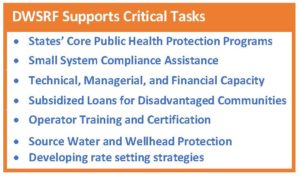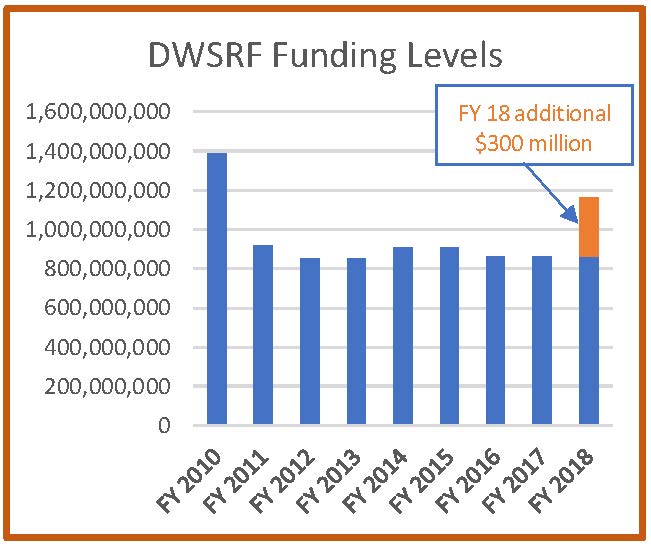DRINKING WATER STATE REVOLVING LOAN FUND (DWSRF)
Public Health Risks from Inadequate Funding
The DWSRF is at a Critical Point
The latest EPA Drinking Water Infrastructure Needs Survey and Assessment (March 2018) places the-20-year national infrastructure needs estimate at $472.6 billion. This is nearly double the need identified in the first survey conducted in 1995. To address these needs, the Drinking Water State Revolving Loan Fund (DWSRF), since its inception in 1997, has been cumulatively capitalized at $20 billion and leveraged by state drinking water programs into $35 billion in loans made to more than 14,000 communities. While at many levels, this 20-year achievement is a success story, it is not sustainable without adequate Federal funding. State drinking water programs need your leadership in ensuring that the DWSRF – a critical component in public health protection – is funded at a level commensurate with demonstrated need.

How the DWSRF Program Operates
Through low-interest loans provided by the DWSRF, states help water utilities comply with the regulations and protect public health. Annually, EPA funds each state’s DWSRF that is matched by a 20% state contribution. The historical payback to the DWSRF on this investment has been exceptional. For every Federal dollar invested, $1.87 is available to help communities.
What Makes the DWSRF Unique
A key component of the DWSRF program are the “set-aside” provisions. Set-asides function as a proactive way for states to work with drinking water systems to maintain compliance and avoid violations. States may reserve approximately 31% of their annual capitalization grant to support a variety of critical tasks that are highlighted above. Congress intentionally designed the DWSRF set-asides to be an essential source of funding for states’ core public health protection programs and to provide the foundation through which water systems can better manage their infrastructure.
DWSRF Supports Disadvantaged Communities
In addition to traditional infrastructure loans, more than 26% of the cumulative DWSRF assistance, including zero-interest loans and principal forgiveness, has been provided to disadvantaged communities. Such investments pay tremendous dividends — both to support our economy and to protect our citizens’ health.

DWSRF and Lead Service Line Replacement
Although not as well defined at the time of the latest Needs Assessment, the national need for lead service line replacement has become a paramount concern. The 2015 assessment did estimate, however, that approximately 1.4 million lead service lines over the 20-year assessment period will need to be replaced at an estimated at $4.2 billion in 2015 dollars and the DWSRF will serve as a significant funding source as many communities struggle to find the resources to undertake these line replacements.
DWSRF and WIFIA are not Interchangeable
It is important to consider the relative roles of the DWSRF and the funding program authorized by the Water Infrastructure Finance and Innovation Act (WIFIA). Created in 2014, WIFIA is a Federal credit program administered by EPA for eligible water and wastewater infrastructure projects. WIFIA focuses on large dollar-value projects of $20 million or more. Designed specifically for infrastructure needs, eligibilities do not include project subsidization for disadvantaged communities or non-infrastructure-based initiatives such as those critical tasks supported by the public health protection goal of the DWSRF. The DWSRF and WIFIA programs are complementary. Neither should serve as a replacement for the other.
Drinking Water Infrastructure Investment is Well below the Documented Need
The Needs Survey and Assessment reports a need that exceeds $472.6 billion. About 88% of that figure represents aging infrastructure needs for source, treatment, storage, and transmission and distribution. Unless those needs are addressed, drinking water systems will not be able to meet their public health protection obligations. This becomes increasingly troublesome when you note that $76.6 billion of the identified need comes from small community water systems serving fewer than 3,300 people. These communities are even less likely to have economies of scale to meet their aging infrastructure needs and are more likely to turn to programs like the DWSRF for financial support.
| Community Water System Size (by population) | Estimated 20 yr Need | |
| $ billions | % of Need | |
| Large CWS (>100,000) | $174.4 | 37.6% |
|
Medium CWS (>3,300 to <100,000) |
$212.3 | 45.8% |
| Small CWS (<3,300) | $76.6 | 16.5% |
The DWSRF Program Must Have Sufficient Funding

States were pleased to learn that the FY 18 Omnibus Appropriations Act includes an additional and much needed $300 million over the $863 million in funding for the DWSRF. Historically, since the $1.387 billion appropriated for the DWSRF in FY 10, the DWSRF has suffered a generally downward trend, as shown in the chart below. The documented need cannot be met by the current funding levels. The primary purpose of the DWSRF is to improve public health protection by facilitating water system compliance with national primary drinking water regulations through the provision of loans to improve drinking water infrastructure. Water infrastructure is needed for public health protection as well as a sustainable economy. Considering these indicators of success and documented needs, continued funding at the FY 18 $1 billion level is essential to enable the DWSRF to meet the SDWA compliance and public health protection goals and support the documented needs of the drinking water community.
Your Help is Essential
A strong state drinking water DWSRF program supported by the Federal-state partnership will ensure that the quality of drinking water in this country will not deteriorate and, in fact, will continue to improve – so that the public can be assured that a glass of water is safe to drink no matter where they travel or live. Since its inception, the DWSRF has touched millions of Americans through projects that enhance drinking water capabilities at water utilities. However, additional Federal financial assistance is needed to meet ongoing and ever-growing infrastructure needs. In 1996, Congress provided the authority to ensure that the burden would not go unsupported. ASDWA asks that the promise of that support continue to be realized.

